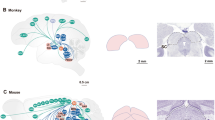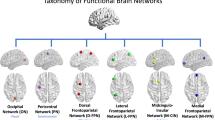Summary
The motor organization of the nucleus lateralis (NL) of the rat's cerebellum was investigated by observing the motor effects of electrical microstimulations of the NL. The movements evoked by the NL mainly concerned forelimb and head segments. Only in a few cases were movements of hindlimb segments evoked. Motor effects were obtained according to a precise topographical pattern. This pattern delimited functional zones, or representations, within the NL, each zone being specifically related to a particular segment of the body. A few body segments were activated from single zones only (single representation) whereas some other body segments could be activated from different zones of the NL. Among them, the axio-proximal body segments were activated in a similar way from all sites (multiple representation) whereas the distal body segments were differently activated from the various representation zones (specific representation). The multiple and specific representations were distributed between the 3 cytoarchitectonic subregions of the NL (NLm, DLH and slp) in such a way that the body segments were usually represented only once in each individual NL subregion. Each NL subregion included sets of representations concerning body segments characterized by a topographical continuity (e.g. the different segments of the forelimb in both DLH and slp). Thus, the individual NL subregions may bring into play coordinate plurisegmental muscular activities of the limbs and/or of the head. The NLm controls movements of all the segments of the head and those of axio-proximal segments of both limbs. The DLH particularly controls movements of the head, including both the proximal (neck) and the oral regions. To a lesser degree, DLH controls movements of the various segments of the forelimb, including synchronous flexion of all the digits. The slp is specifically involved in the control of motor activities of: i) the proximal segment of the head (rotation of the neck) as well as its distal segments (displacement of individual vibrissae, rotation of the ear pinna) and ii) the various segments of the forelimb including individual digits. Functionally, the proximal segments would be concerned in the spatial displacement of the limbs or of the head whereas the distal segments would be involved in the realization of precise and discrete movements related to specific functions of the distal segments concerned. The 3 subregions of the NL may be concerned in different motor functions. The results suggest the involvement of: i) the NLm in the postural adjustments of the body, or of part of it; ii) the DLH in motor behaviours which integrate the oral and the forelimb motor activities; iii) the slp in exploratory activities (by moving individual vibrissae, the ear pinna and individual digits) and/or in discrete manipulative activities.
Similar content being viewed by others
References
Angaut P, Cicirata F (1982) Cerebello-olivary projections in the rat: an autoradiographic study. Brain Behav Evol 5: 24–33
Angaut P, Cicirata F, Serapide MF (1985) Topographic organization of the cerebello-thalamic projections in the rat. An autoradio-graphic study. Neuroscience 15: 389–401
Angaut P, Cicirata F, Serapide MF (1987) The dentatorubral projection in the rat: an autoradiographic study. Brain Behav Evol 30: 272–281
Asanuma C, Thach WT, Jones EG (1983) Anatomical evidence for segregated focal grouping of efferent cells and their terminal ramifications in the cerebellothalamic pathway of the monkey. Brain Res Rev 5: 267–297
Cicirata F, Angaut P, Cioni M, Serapide MF, Papale A (1986) Functional organization of the thalamic projections to the motor cortex: an anatomical and electrophysiological study in the rat. Neuroscience 19: 81–99
Cicirata F, Angaut P, Panto MR, Serapide MF (1989) Neocerebellar control of the motor activity: experimental analysis in the rat: comparative aspects. Brain Res Rev 14: 117–141
Demole V (1927) Structure et connexion de noyaux denteles du cervelet. Schweiz Arch Neurol Psychiat 271: 293–315
Erickson RP (1966) Non traumatic headholders for mammals. Physiol Behav 1: 97–98
Flood S, Jansen J (1961) On the cerebellar nuclei in the cat. Acta Anat 46: 52–72
Gentilucci M, Fogassi L, Luppino G, Matelli M, Camarda R, Rizzolatti G (1988) Functional organization of inferior area 6 in the macaque monkey I. Somatotopy and the control of proximal movements. Exp Brain Res 71: 475–490
Goodman LS, Gilman A (1987) Le basi farmacologiche della terapia, VII edn. Zanichelli, Bologna, 334
Goodman DC, Hallet RE, Welch RB (1963) Patterns of localization in the cerebellar corticonuclear projections of the albino rat. J Comp Neurol 121: 51–67
Hari R, Hamalainen H, Hamalainen M, Kekoni J, Sams M, Tiihonen J (1990) Separate finger representations at the human second somatosensory cortex. Neuroscience 37: 245–249
Himwich HE, Callison DA (1972) The effects of alcohol on evoked potentials of various parts of the central nervous system of the cat. In: Kissin B, Begleiter H (eds) The biology of alcoholism, Vol 2. Physiology and behaviour. Plenum, New York, pp 67–84
Kaas JH, Sur M, Nelson RJ, Merzenich MM (1981) The postcentral somatosensory cortex: multiple representations of the body primates. In: Woolsey CN (ed) Cortical sensory organization, Vol 1. Multiple somatic areas. Humana Press, Clifton NJ, 29–45
Keane PE, Biziere K (1987) The effects of general anaesthetic on GABAergic synaptic transmission. Life Sci 41: 1437–1448
Korneliussen HK (1968) On the morphology and subdivision of the cerebellar nuclei of the rat. J Hirnforsch 10: 109–122
La Motte RH, Mountcastle WB (1979) Disorders in somesthesis following lesions of parietal lobe. J Neurophysiol 42: 400–419
Pappas CL, Strick PL (1979) Double representation of the distal forelimb in cat motor cortex. Brain Res 167: 412–416
Paul RL, Merzenich M, Goodman H (1972) Representation of slowly and rapidly adapting cutaneous mechanoreceptors of the hand in Brodmann's areas 3 and 1 of macaca mulatta. Brain Res 36: 229–249
Rapisarda C, Palmen A, Aicardi G, Sapienza S (1990) Multiple representations of the body and input-output relationships in the agranular and granular cortex of the chronic awake guinea pig. Somatosen Motor Res 7: 289–314
Rand RW (1954) An anatomical and experimental study of the cerebellar nuclei and their efferent pathways in the monkey. J Comp Neurol 101: 167–223
Rispal-Padel L, Cicirata F, Pons C (1982) Cerebellar nuclear topography of simple and synergistic movements in the alert baboon (Papio papio). Exp Brain Res 47: 365–380
Rispal-Padel L, Latreille J (1974) The organization of projections from the cerebellar nuclei to the contralateral motor cortex in the cat. Exp Brain Res 19: 36–60
Ritchie JM (1980) Aliphatic alcohols. In: Gilman AG, Goodman LS, Gilman A (eds) The pharmacological basis of therapeutics. MacMillan, New York, pp 376–390
Rizzolatti G, Camarda R, Fogassi L, Gentilucci L, Luppino G, Matelli M (1988) Functional organization of inferior area 6 in the macaque monkey. II. Area F5 and the control of distal movements. Exp Brain Res 71: 491–507
Stanton GB (1980) Topographical organization of ascending cerebellar projections from the dentate and interposed nuclei in Macaca Mulatta. An anterograde degeneration study. J Comp Neurol 190: 688–731
Strick PL, Preston JB (1978a) Multiple representation in the primate motor cortex. Brain Res 154: 366–370
Strick PL, Preston JB (1978b) Multiple representation in the motorcortex: a new concept of input-output organization for the forearm representation. In: Asanuma H, Wilson VJ (eds) Integration in the nervous system. Igaku-Shoin, Tokyo, New York, pp 205–219
Sur M, Nelson RJ, Kaas JH (1978) The representation of the body surface in somatosensory area I of the grey squirrel. J Comp Neurol 179: 425–450
Verdié JC (1975) Le noyau dentelé. Thèse de doctorat d'Etat en Medicine, Université Paul Sabatier, Toulouse
Waters RS, Samulack DD, Dykes RW, McKinley PA (1990) Topographic organization of baboon primary motor cortex: face, hand, forelimb, and shoulder representation. Somatosens Motor Res 7: 485–514
Author information
Authors and Affiliations
Rights and permissions
About this article
Cite this article
Cicirata, F., Angaut, P., Serapide, M.F. et al. Multiple representation in the nucleus lateralis of the cerebellum. Exp Brain Res 89, 352–362 (1992). https://doi.org/10.1007/BF00228251
Received:
Accepted:
Issue Date:
DOI: https://doi.org/10.1007/BF00228251




